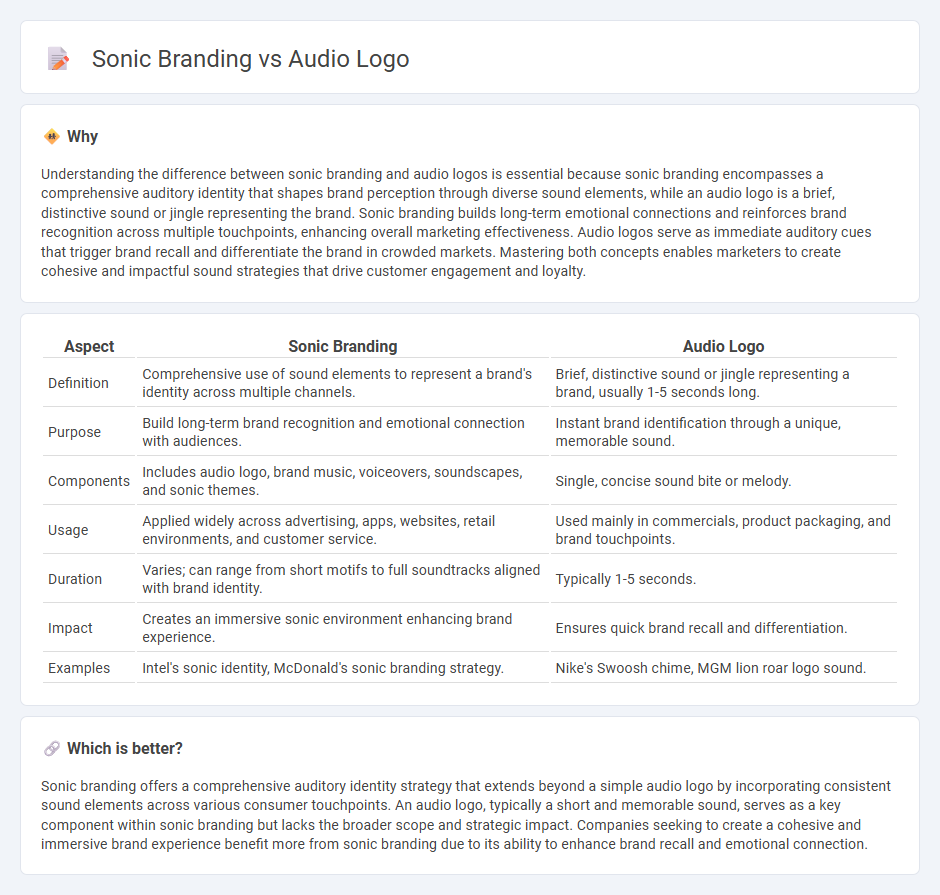
Sonic branding uses a broader range of audio elements to create a consistent and memorable brand identity, while an audio logo is a short, distinctive sound or jingle representing the brand. Brands like Intel and McDonald's leverage sonic branding to enhance customer recall and emotional connection through strategic sound design. Explore how sonic branding and audio logos can elevate your marketing strategy.
Why it is important
Understanding the difference between sonic branding and audio logos is essential because sonic branding encompasses a comprehensive auditory identity that shapes brand perception through diverse sound elements, while an audio logo is a brief, distinctive sound or jingle representing the brand. Sonic branding builds long-term emotional connections and reinforces brand recognition across multiple touchpoints, enhancing overall marketing effectiveness. Audio logos serve as immediate auditory cues that trigger brand recall and differentiate the brand in crowded markets. Mastering both concepts enables marketers to create cohesive and impactful sound strategies that drive customer engagement and loyalty.
Comparison Table
| Aspect | Sonic Branding | Audio Logo |
|---|---|---|
| Definition | Comprehensive use of sound elements to represent a brand's identity across multiple channels. | Brief, distinctive sound or jingle representing a brand, usually 1-5 seconds long. |
| Purpose | Build long-term brand recognition and emotional connection with audiences. | Instant brand identification through a unique, memorable sound. |
| Components | Includes audio logo, brand music, voiceovers, soundscapes, and sonic themes. | Single, concise sound bite or melody. |
| Usage | Applied widely across advertising, apps, websites, retail environments, and customer service. | Used mainly in commercials, product packaging, and brand touchpoints. |
| Duration | Varies; can range from short motifs to full soundtracks aligned with brand identity. | Typically 1-5 seconds. |
| Impact | Creates an immersive sonic environment enhancing brand experience. | Ensures quick brand recall and differentiation. |
| Examples | Intel's sonic identity, McDonald's sonic branding strategy. | Nike's Swoosh chime, MGM lion roar logo sound. |
Which is better?
Sonic branding offers a comprehensive auditory identity strategy that extends beyond a simple audio logo by incorporating consistent sound elements across various consumer touchpoints. An audio logo, typically a short and memorable sound, serves as a key component within sonic branding but lacks the broader scope and strategic impact. Companies seeking to create a cohesive and immersive brand experience benefit more from sonic branding due to its ability to enhance brand recall and emotional connection.
Connection
Sonic branding and audio logos are intrinsically connected as essential components of auditory brand identity, where sonic branding encompasses the overall strategy of using sound to express a brand's personality and values. An audio logo serves as a concise, memorable sound snippet within sonic branding that reinforces brand recognition and emotional connection. Effective integration of audio logos within a sonic branding framework amplifies brand recall and differentiates a brand in competitive markets.
Key Terms
Brand Identity
Audio logos are brief, distinctive sound cues designed to trigger instant brand recognition, while sonic branding encompasses a broader strategy integrating sound elements across multiple touchpoints to shape brand identity and emotional connection. The strategic use of melody, rhythm, and voice in sonic branding creates a cohesive auditory experience that reinforces brand values and fosters long-term consumer loyalty. Explore how leveraging audio logos within a comprehensive sonic branding framework can elevate your brand identity and deepen audience engagement.
Sound Design
Audio logos are brief, distinctive sound signatures used to instantly identify a brand, typically lasting only a few seconds. Sonic branding encompasses the broader strategy of incorporating sound design elements like audio logos, jingles, and soundscapes to create a cohesive auditory identity that enhances brand recognition across multiple platforms. Explore how effective sound design can elevate your brand's presence in the competitive market.
Audio Recognition
Audio logos are brief, distinctive sound bites designed to instantly identify a brand through sonic signatures recognized by audio recognition technology. Sonic branding encompasses a broader strategy, including audio logos, jingles, and soundscapes, all optimized for consistent brand recall across digital and physical environments. Discover how leveraging audio recognition can enhance brand identity and drive consumer engagement.
Source and External Links
The significance of an audio logo for brands - An audio logo is a brief 3-5 second sound or musical clip that acts as a brand's sound symbol, essential for creating a distinctive identity and emotional connection across various advertising channels.
15 of the best audio logos and why they work - Iconic examples like Intel's and Cadbury's audio logos demonstrate how simple, memorable sonic logos convey brand values such as reliability and tradition through carefully composed short sound sequences.
Audio Logos - In podcasting, audio logos serve as consistent intros or outros added to episodes, reinforcing brand identity and enhancing listener experience by playing a short branded audio segment.
 dowidth.com
dowidth.com